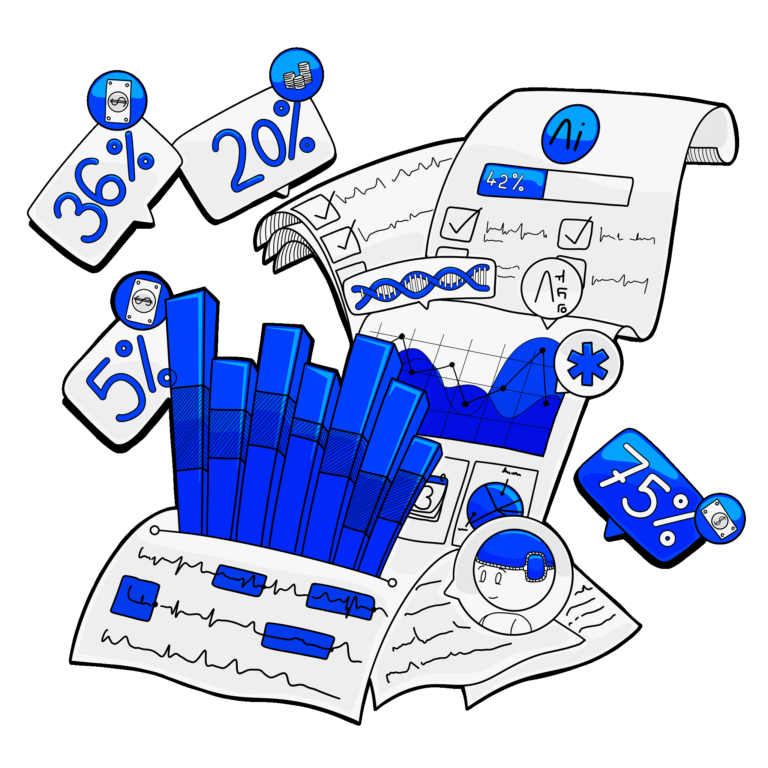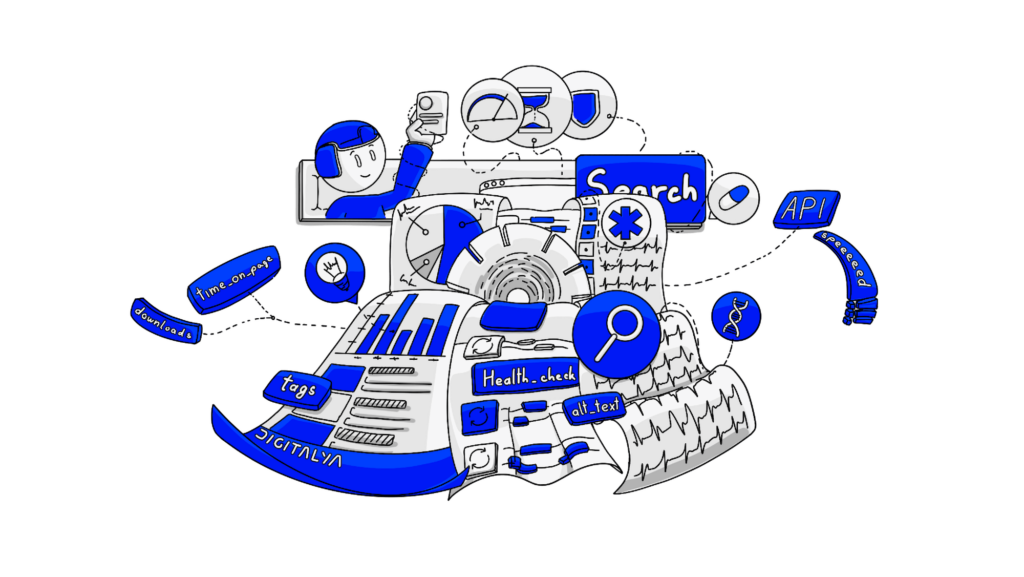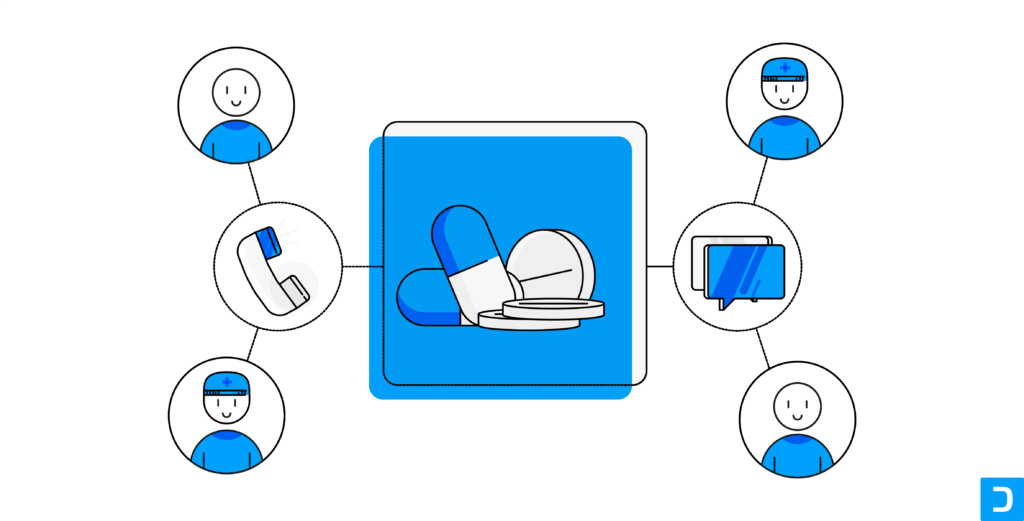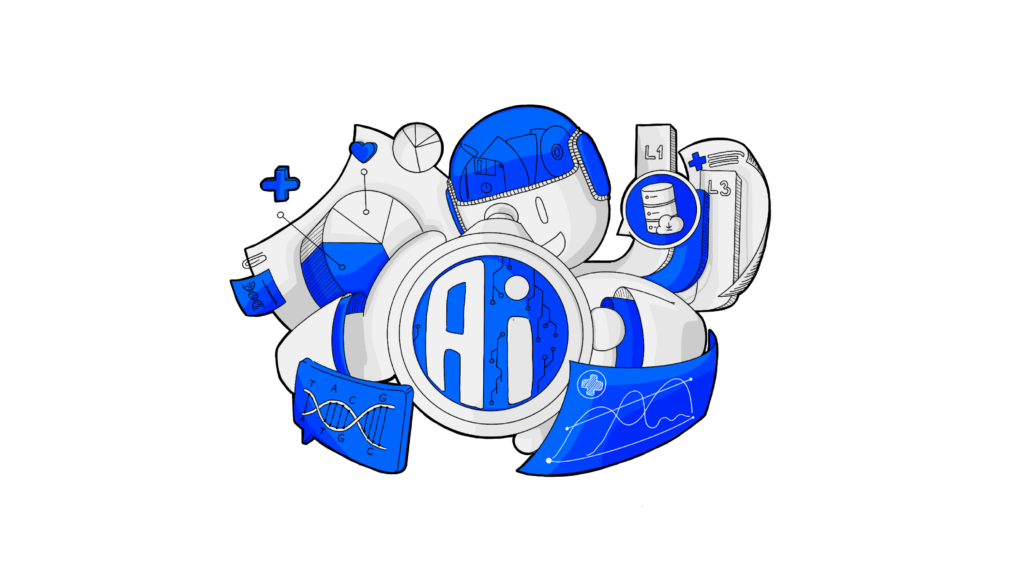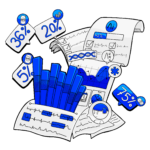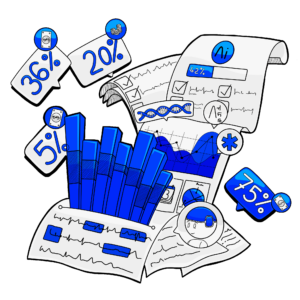Online learning had already been around for years when the pandemic started and made its benefits even clearer. For the past two years, learning institutions and companies have become more interested in using digital platforms to train students and employees.
This, of course, increased the Learning Management Systems (LMS) market. We even expect to reach a $7.570 million value by 2026. In 2020, at the beginning of the pandemic, in North America, 70% of L&D departments used a learning management system (LMS) for employee training, half more than the previous year.
Still, the healthcare industry favored traditional education means; digital healthcare training was not on most people’s minds when speaking of LMSes. Reality and the global context forced a rapid change, and now we can easily talk about LMS for healthcare.
1. What is LMS healthcare?
A healthcare learning management system, or simply healthcare LMS, is a type of learning platform that works as a SaaS, used by companies in the healthcare industries or hospitals to train and upgrade the skills of medical professionals. Not only large organizations need or can use it, but a medical practices, too. Like any learning management system or training software, you can use it for onboarding or to enrich employee skills. A healthcare organization can use LMS software for medical training and training its staff on the latest technologies, standards, best practices, guidelines, or even selling techniques.
Healthcare learning is a continuous, lifetime process. What makes the mission of healthcare professionals even more difficult is that they need to combine a highly demanding job with learning efforts in the span of a regular day. An LMS for healthcare, due to its accessibility online or on mobile devices and its degree of customization, makes the learning or training process much more affordable in terms of time and effort investment.
Healthcare organizations (hospitals, companies, practices) have quickly understood its benefits. The market for healthcare LMS software is expected to go beyond $3.5 billion by 2030, with an almost 22% compound annual growth rate (CAGR).
2. How to create a healthcare learning management system?
An LMS for healthcare is not exactly your average LMS software. Think only about all the regulations and compliances required by the medical industry. If you want to use elearning solutions to train your staff regarding healthcare-related subjects and skills, then it may make more sense to have developed your own LMS solution rather than adapt and use one from an LMS vendor.
You probably do not have the in-house development talent needed to build a customized healthcare management system (LMS), so the way to do it is to contract a company specialized in custom software development or web app development. Nevertheless, you should know what to expect from the process.
Audience
As with any software development, it starts with the user. For whom are you building it? What do those persons need from a learning management system? Who are they? How much time do they have to invest in learning? How motivated are they? What do you want/ need them to learn? How complex are the subjects?
Build your user (or customer) persona to have a clear view of the user journey and the main LMS features you need to include.
Compliance
Maybe you won’t need as many security requirements as other medical app development cases. Nevertheless, the healthcare industry has a lot of regulations in place, so even if you’re building training solutions, the training material may need to comply with specific requirements.
App architecture and MVP
Based on what you know about the user, the training process, and what kind of elearning content you need to deliver (written, video, graphics, images, interactive quizzes or images, tests and scoring system, gamification elements, etc.), draw the architecture of your training software. Don’t worry about perfecting it the first time – it won’t happen. Just focus on including the essentials and building a functional MVP; leave room for flexibility, as it never ends up exactly as you expected after testing it.
Start developing the MVP of your LMS for healthcare. Don’t wait to have all the learning content in place. To test, you can only apply for one or two courses; you only need the users to get the hang of the tool and for you to observe how they use it and what needs adjustments.
Test, get feedback, adjust, launch
There’s good reason in encouraging development teams not to wait for a perfect final version and get going with a minimum viable product – you can never anticipate the exact behavior or need of a genuine user. Get your team to test the MVP for the learning management system. Then adjust features, design, content, and whatever needs more tweaking.
Upload content and launch
Once the user journey runs smoothly, you can start creating (if you haven’t already) the training content, populate the platform with learning material, and get people to use it.
3. How much does it cost to develop a LMS in healthcare
This is never an easy question, as the costs depend on many variables. There are, however, some main categories that we can approximate.
Let’s assume that you plan to have the LMS for healthcare built to help train your employees – so you won’t require an external business analyst (to figure out how to monetize the LMS software).
You will probably go for a software vendor (or several), who provides some or all of the services:
- Software Architecture
- UX and UI Design
- Development
- Support
Add the cloud hosting cost (if you plan a cloudbased learning management system) or the internal infrastructure cost. Take into account that the training material (especially if rich in videos and images) will require considerable storing capacity, stability (you don’t want the platform to crash in the middle of a test), and ease of access (the users are people with hectic and stressful jobs, so their patience may run short very quickly).
To detail further, for both UX Design and development, consider that you’ll need two types of interfaces:
- An admin interface – for those who manage (or even create) the learning content and analyze test results and student progress. Although not the app’s main focus, it should be user-friendly enough, so it doesn’t drive your team crazy when working with the platform; otherwise, they’ll just quit administrating it.
- The user interface – for the learners, who are the primary beneficiaries of your LMS for healthcare. Needless to say, user experience is extremely important. The better the user interface, the more encouraged people feel to use it as much as possible, resulting in improved knowledge and skills.
As for the development, it, too, depends on where the LMS software is available:
- Web app only
- Web and mobile
- Just mobile
These are some of the main cost-bearing aspects of developing healthcare learning software. Now, let’s see some numbers.
Here are some approximate hourly fees:
- Software architects may charge between 50 and 80 EUR / hour.
- Design time can cost between 30 and 150 EUR/ hour.
- Development time is evaluated at 35 to 55 EUR/ hour.
- Testing can cost from 30 to 50 EUR/ hour.
Depending on the learning platform’s complexity, it will take more or less time to create it. Building an admin interface that allows course creation and delivery, automated notifications, and student engagement can cost from 2000 to 8000 EUR. A high-quality, engaging, easy-to-navigate user interface implies a skilled designer who may cost between 100 and 150 EUR.
We haven’t included so far the costs to create the elearning courses. These, too, should be taken into account – someone to gather and curate the information, write the presentations, put the content into an attractive form (video creation or graphic design), and deliver the presentations – if audio or video recorded. You could go with a training provider, who can do most of these jobs, or with separate specialists, including people from your own team.
On a rough calculus, approximating the lowest hourly rate of 35 EUR with a necessary time of about 2000 hours to design and build a healthcare learning management system, the total cost may rich 70 000 EUR. There are still differences in the size of your company, which translate into the learning system’s complexity. The cost may be even lower for startups, around 55 000 EUR, while for medium businesses or growing companies, it can reach 115 000 EUR. On the other hand, an extended enterprise could go up to 600 000 EUR if the LMS is built from the ground up.
4. How is LMS different from CMS?
Just a little reminder: LMS is the acronym for Learning Management System.
Now, CMS is one consonant away, meaning Content Management System. CMS is a platform or framework where users can store, manage and deliver various types of content: images, files, text, audio, and video. For instance, WordPress is probably the most popular example of CMS. Such content management systems are mostly designed for people who don’t have the knowledge and skills to build or administrate a website, so the system’s admin interface makes it easier with pre-designed templates and processes.
A learning management system is a particular example of a CMS, as it is also a platform that allows the creation, upload, administration, and display of content. This time, the content is strictly dedicated to learning purposes. A training LMS can prove more flexible than a CMS, especially on the Admin side (track learning progression for individuals, automate advancement based on previous behavior, interact with data, etc.) and especially if it is custom-built.
What is LCMS vs LMS
Let’s make things a bit more complex and add another consonant to the dilemma: what about LCMS? What is it, and how is it different from an LMS?
As you probably guessed, LCMS stands for Learning Content Management System. Its name suggests it is a platform at the crossroads of CMS and LMS. This means that this type of LMS platform is designed mainly for elearning content creation, storing, and organizing. Training content is usually developed, managed, and published using such LCMSes. The advantage of such a platform is that you can deliver customized training by modifying single courses for an individual learner instead of dealing with an entire course catalog. Another feature of an LCMS is allowing collaboration on content creation and delivery in multiple formats.
To put it shortly, the LMS is a platform focused on the learner as a user, while the LCMS is designed for the creators of learning content.
5. Why you Need an LMS for Healthcare
If you run a company or organization in the healthcare industry, you may wonder why should you invest in having developed an LMS for healthcare?
The fact that most „traditional” processes are turning digital may not be a strong enough reason. So let’s look at the context and particular benefits.
In the U.S. alone, from 2020 to 2030, healthcare employment is expected to grow by 16%, faster than the growth in other industries. In 2020, the global healthcare market was valued at over $4 trillion and was projected to reach $7 trillion in 2025. This is to say that there is pressure from the market towards quality employees and employment conditions, of which professional development opportunities are considered an advantage.
Still, why a digital learning system to train the personnel? Let’s look at the benefits:
Reduced costs – no need for a physical space, an instructor to come for different student groups, or printed materials. You only need the tutor to create the course. Then it becomes available to many students whenever they feel comfortable.
Faster learning results – with an LMS for healthcare, your personnel can use their time for learning efficiently, so they complete courses faster than they would have if attending pre-scheduled physical classes. This translated into the faster-growing quality of the healthcare services delivered.
Easy updates and uploads of learning content – no need to explain how rapidly the demands and compliances in the healthcare industry change and how fast technological advancements happen. To keep the pace with the compliance training and all the novelty is a constant effort. It would be much harder if pursued in a classical learning system manner. Elearning courses are easy to update and access by medical personnel who needs to stay up-to-speed.
Faster employee onboarding – not only specific medical skills can be trained with the help of such a cloudbased learning management software. New medical personnel joining your company can use the LMS platform to learn fast and easily about the company’s policies and organizational culture.
More efficient learning – the LMS software allows customization, meaning that courses and the learning process can be adapted to various types of learners. This translates into better results; people acquire information and skills much better if delivered in their own manner of learning, adapted to their own rhythm.
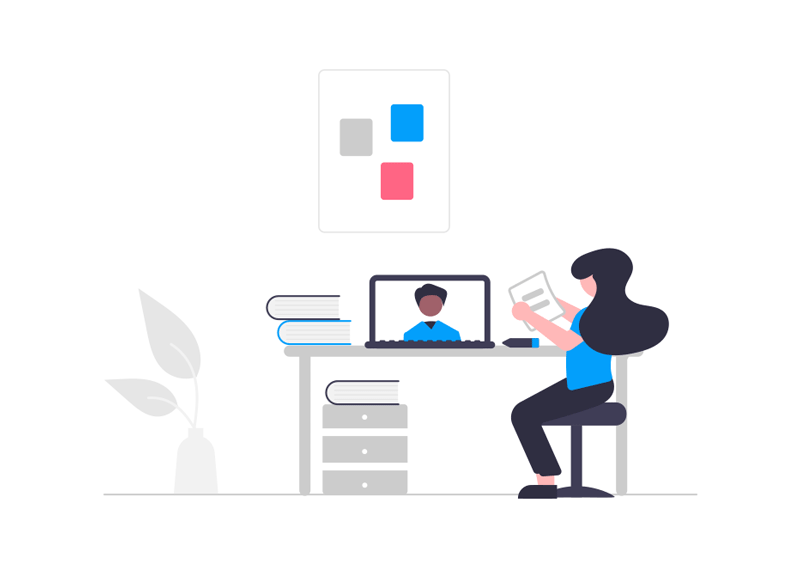
6. What is the most commonly used LMS?
If you think that a LMS for healthcare is the solution for your talent management needs, the next question is whether you should create a custom LMS or acquire a license for an existing learning platform. The advantage of custom-made software is exactly that – personalization to your particular needs. Still, it requires time and serious investment.
On the other hand, choosing an LMS suited to your training management requirements is no easy task.
For instance, on Capterra, the shortlist of the best learning management systems in 2022 showed NEOGOV as the most popular and with the best rating scores. This platform, however, serves “the public sector and higher education markets.”
Next, Thinkific is slightly less popular but with a similarly high rating score. It is appropriate for various businesses and organizations of different sizes and industries.
Another online publication, Financesonline, named Coassemble (the former eCoach) the most popular cloudbased learning management system.
Also, in 2022, Absorb LMS was named the best in the Software Testing Help online publication of the year.
The best way to decide is to check the features of at least the top 5 most popular LMSes and decide for yourself which one suits your organization the best.
Five Best Healthcare LMS (Learning Management Systems) for 2023 and beyond
Let’s take a look at the healthcare industry and see which are the best options for LMS healthcare companies can use. Here are the top healthcare LMS choices for 2022, according to Software Advice:
- Absorb LMS
- SAP Litmos
- BRIDGE
- Docebo
- LearnUpon
You can also check for our choices of top healthcare apps that cover more than learning purposes.
7. Key LMS Features a Healthcare app should have
Here are some key features you should consider for your LMS for healthcare.
To offer quality learning experiences, the LMS features should include at least these elements:
- Course catalog
- Student performance tracking
- Learning path management
- Gamification feature
- Notifications
- Reporting
It is essential to deliver learners engaging courses and help trainers understand the learning path of the “students” so they can adapt the courses and intervene for maximum results.

